Not just Boracay...
Travelling in Busan as a Muslim: Halal Food, Mosques & More
Busan, South Korea's vibrant coastal city, offers Muslim travellers a unique blend of spiritual comfort, culinary delights, and cultural experiences. From prayer spaces to halal-friendly eateries and scenic attractions, here's how you can make the most of your visit while adhering to your religious needs.
Best time to visit Busan
Timing your visit to Busan can make all the difference to your trip. Understanding Busan’s seasonal charms will help you decide when to enjoy the city’s vibrant sights, flavours, and experiences at their best.
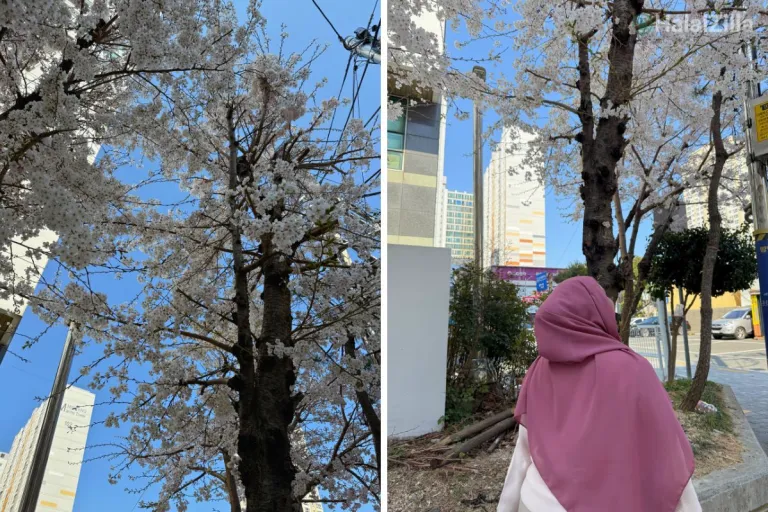 If you want to catch Busan at its most beautiful, early April is the sweet spot. That’s when I visited, and it couldn’t have been more perfect. The weather was just right – not too chilly, but also not too warm. And the cherry blossoms were in full, glorious bloom! Spring (Apr to Jun) is an ideal time for beach strolls and outdoor adventures, before the summer crowds and heat roll in – especially since Busan is a popular destination for local Korean travellers too.
If you want to catch Busan at its most beautiful, early April is the sweet spot. That’s when I visited, and it couldn’t have been more perfect. The weather was just right – not too chilly, but also not too warm. And the cherry blossoms were in full, glorious bloom! Spring (Apr to Jun) is an ideal time for beach strolls and outdoor adventures, before the summer crowds and heat roll in – especially since Busan is a popular destination for local Korean travellers too.
If you prefer fewer crowds and cooler weather, then Autumn (Sep to Nov) would be a more ideal time to visit to experience the crisp air and fiery fall colours. It’s a peaceful time to explore Busan’s coastal beauty and cultural gems.
But no matter when you visit, it helps to know where you can find facilities and spaces that cater to Muslim needs. Here are some key spots that can make your Busan trip more comfortable and spiritually fulfilling!
Visit Busan’s only mosque, Busan Al-Fatah Mosque
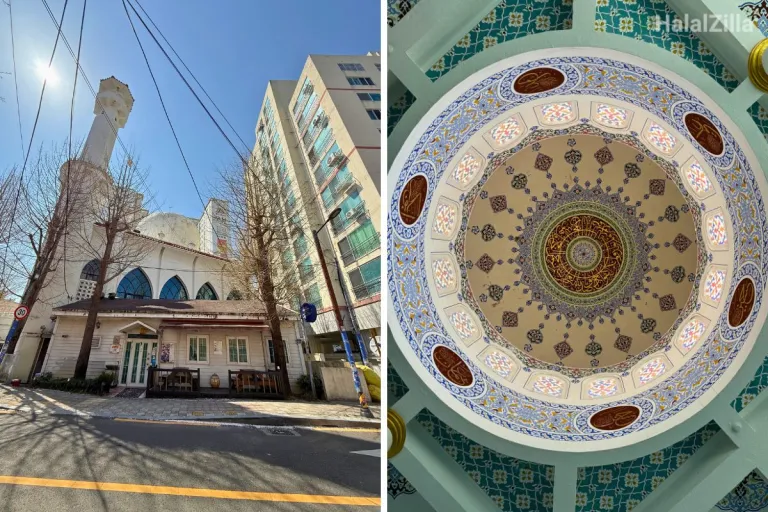 Busan Al-Fatah Mosque is the city’s only mosque, and while it’s about an hour from central Busan, getting there is easy via public transport. From Dusil Station, it’s just a short 8-minute walk from Exit 8.
Busan Al-Fatah Mosque is the city’s only mosque, and while it’s about an hour from central Busan, getting there is easy via public transport. From Dusil Station, it’s just a short 8-minute walk from Exit 8.
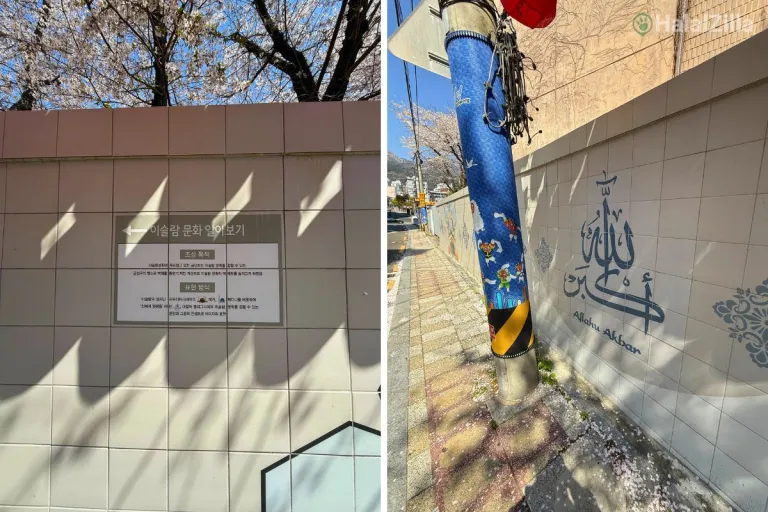 As you approach the mosque, don’t miss the Islamic mural art lining the walls outside; not only is it visually striking, but it also offers a gentle introduction to Islam for the wider community.
As you approach the mosque, don’t miss the Islamic mural art lining the walls outside; not only is it visually striking, but it also offers a gentle introduction to Islam for the wider community.
You can find more information on prayer spaces beyond the Al-Fatah Mosque here.
HalalZilla Tip: If you want to perform salah in Jamaah, visit the mosque on a Friday! Otherwise, the mosque is fairly empty but still open for regular salah.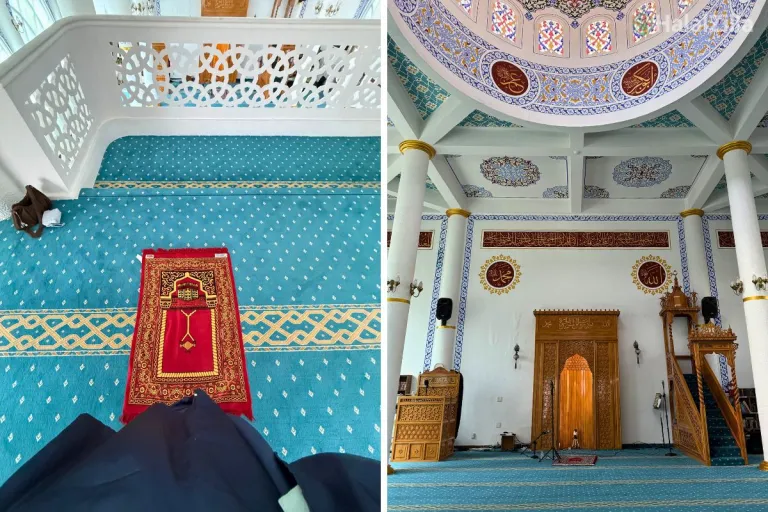
Stepping into the mosque was a special moment for me as it was my first time visiting a mosque in an East Asian country, and it felt incredibly heartwarming to see signs of a growing Muslim community in Busan. The mosque itself is beautifully maintained, with separate prayer spaces for men and women, and even a small library area with books in multiple languages, including Korean. I prayed in the women’s prayer section, which was clean, peaceful, and welcoming, including clean prayer mats and prayer clothes.
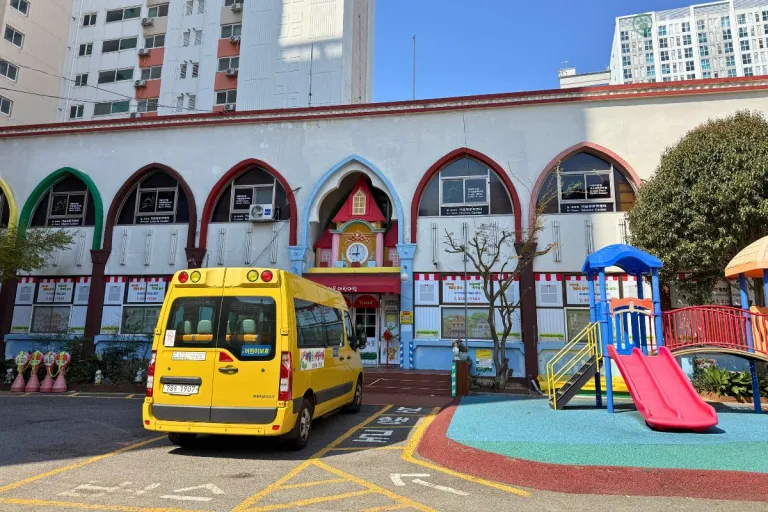 As the mosque is located in a residential area, right next door, you’ll spot an Islamic kindergarten that provides Quran and Arabic lessons to young Muslim kids in the area.
As the mosque is located in a residential area, right next door, you’ll spot an Islamic kindergarten that provides Quran and Arabic lessons to young Muslim kids in the area.
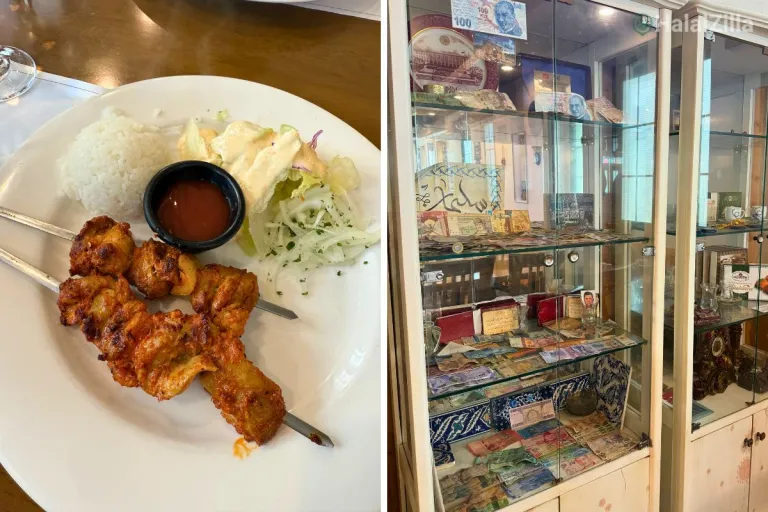 After my prayers, we made our way to lunch at a nearby halal-certified Turkish restaurant, Cappadocia. I had a delicious chicken kebab, and the kind local owner proudly showed me a collection of international currencies gifted to him by travellers from around the world.
After my prayers, we made our way to lunch at a nearby halal-certified Turkish restaurant, Cappadocia. I had a delicious chicken kebab, and the kind local owner proudly showed me a collection of international currencies gifted to him by travellers from around the world.
Indulge in Muslim-friendly dining options
That satisfying meal reminded me just how diverse the halal food scene in Busan can be — if you know where to look. Still, navigating the local food scene as a Muslim traveller can be tricky, especially if you’re craving something authentically Korean.
Let’s be real, finding local halal-certified food in Busan isn’t exactly easy. Most halal-certified restaurants here are Indian, Pakistani, or Middle Eastern, which is a convenient option if you’re looking for familiar flavours. But if you're looking for authentic Korean flavours and are open to seafood and vegetarian options, then I’ve got your back! Plus, there are a handful of rare gems serving local halal-friendly Korean food too!
Image credit: Visit Korea | Official Website
Look out for halal certification signs at restaurants, or check for “pork-free” labels if you’re navigating grey areas.
1. Seoul Samgyetang (원조서울삼계탕), Nampodong
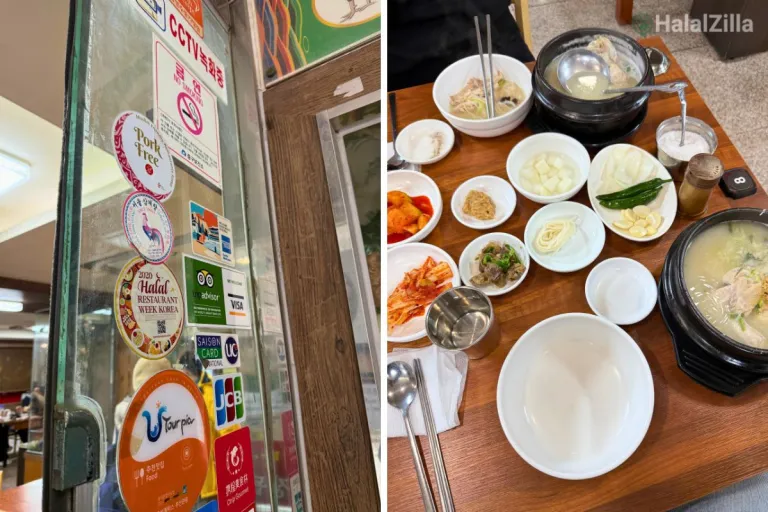 For a truly local dish, head to Seoul Samgyetang, where you can enjoy a pork-free version of Korea’s famous ginseng chicken soup. I got an entire chicken served bubbling hot in ginseng broth, and it came stuffed with glutinous rice!
For a truly local dish, head to Seoul Samgyetang, where you can enjoy a pork-free version of Korea’s famous ginseng chicken soup. I got an entire chicken served bubbling hot in ginseng broth, and it came stuffed with glutinous rice!
The flavour is quite mild, so you’re meant to season it yourself. I dipped the tender chicken in salt, mixed it into the soup, and had it with sides like kimchi and noodles.
2. Jeonpo Cafe Street
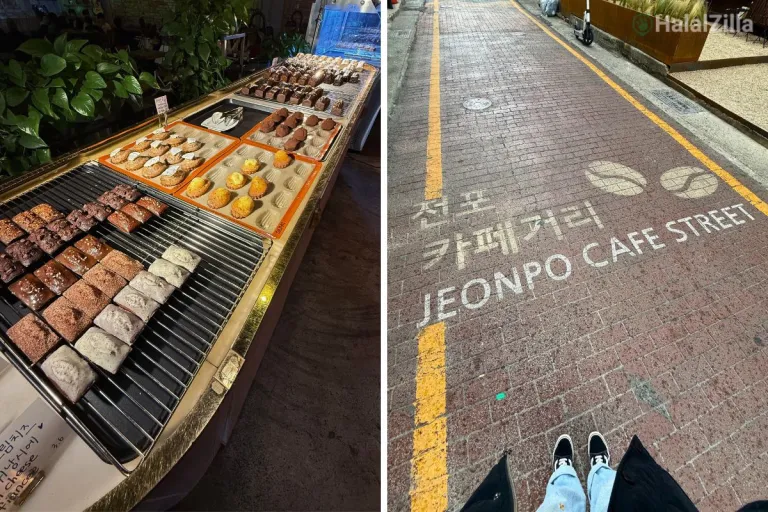 Next on our list would be Jeonpo Café Street for a lighter, trendier bite. This stylish café street is a dream for vegetarian and pescatarian travellers. Most of the cafés don’t serve meat, which makes it easy to find something delicious.
Next on our list would be Jeonpo Café Street for a lighter, trendier bite. This stylish café street is a dream for vegetarian and pescatarian travellers. Most of the cafés don’t serve meat, which makes it easy to find something delicious.
I stopped by Vintage 38, a 24-hour café with fluffy mini madeleines and iced lattes that hit the spot. Plus, the vibes here are just chef’s kiss, with their artsy walls, neon lights, and indie playlists. Other cute cafés to check out include Crashop, Daunt, and DDO Greek.
3. Street food at BIFF Square
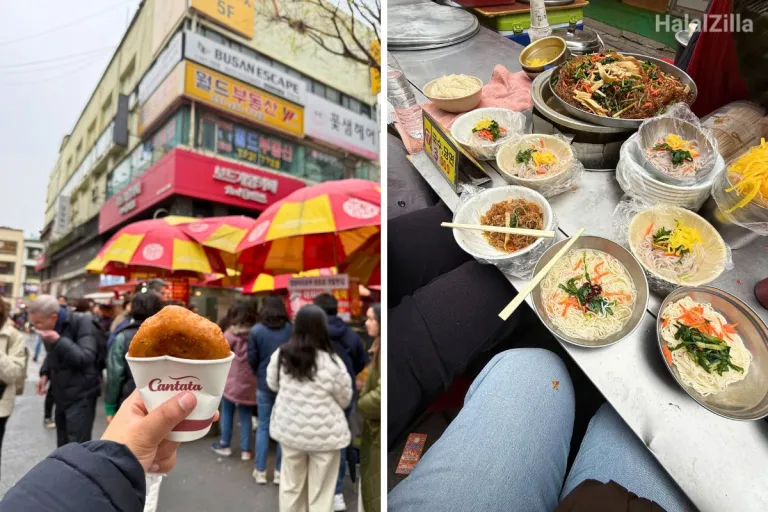 Cafe-hopping is fun, but when in Korea, street food is a must. BIFF Square, known for the Busan International Film Festival, is also a street food heaven. And the best part? Tons of tasty meat-free options that won’t break the bank. I found a whole alley of ahjummas serving veggie noodles with rice rolls and kimchi — super filling and satisfying!
Cafe-hopping is fun, but when in Korea, street food is a must. BIFF Square, known for the Busan International Film Festival, is also a street food heaven. And the best part? Tons of tasty meat-free options that won’t break the bank. I found a whole alley of ahjummas serving veggie noodles with rice rolls and kimchi — super filling and satisfying!
While you’re here, don’t miss the seed hotteok, a crispy Korean pancake filled with honey and seeds. It’s hot, sweet, and so addictive. Also, try Busan’s famous fish cakes, which are generally seafood-based, just double-check the ingredients, as some might have pork mixed in.
4. Seafood delights at Jagalchi Market and Yeongdo Haenyeo Village
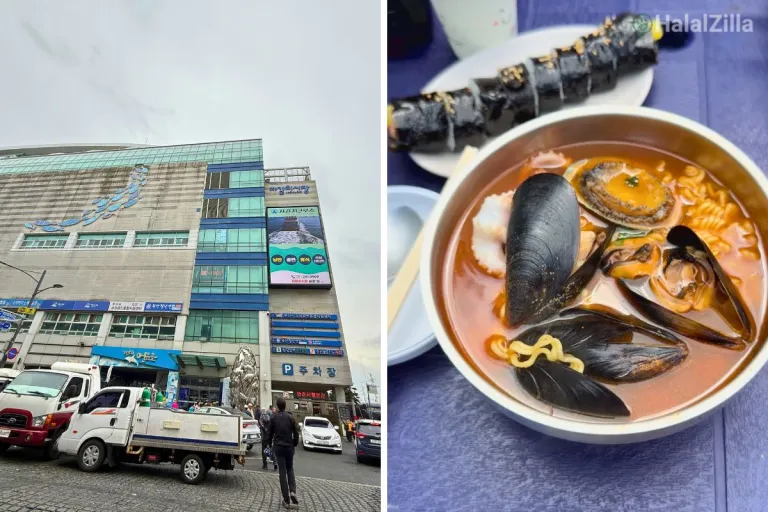 If fish cakes aren’t quite enough to satisfy the seafood lover in you, Busan’s coastal charm truly shines in its fresh seafood offerings. At Jagalchi Market, Korea's largest seafood market, you can select live seafood and have it prepared on the spot. Similarly, Yeongdo Haenyeo Village offers a glimpse into the lives of Korea's famous female divers and a chance to enjoy freshly harvested seafood.
If fish cakes aren’t quite enough to satisfy the seafood lover in you, Busan’s coastal charm truly shines in its fresh seafood offerings. At Jagalchi Market, Korea's largest seafood market, you can select live seafood and have it prepared on the spot. Similarly, Yeongdo Haenyeo Village offers a glimpse into the lives of Korea's famous female divers and a chance to enjoy freshly harvested seafood.
5. Other notable restaurants (aka my faves)!
Sometimes, all you want is a comforting Korean meal that feels like a warm hug, and these spots definitely delivered.
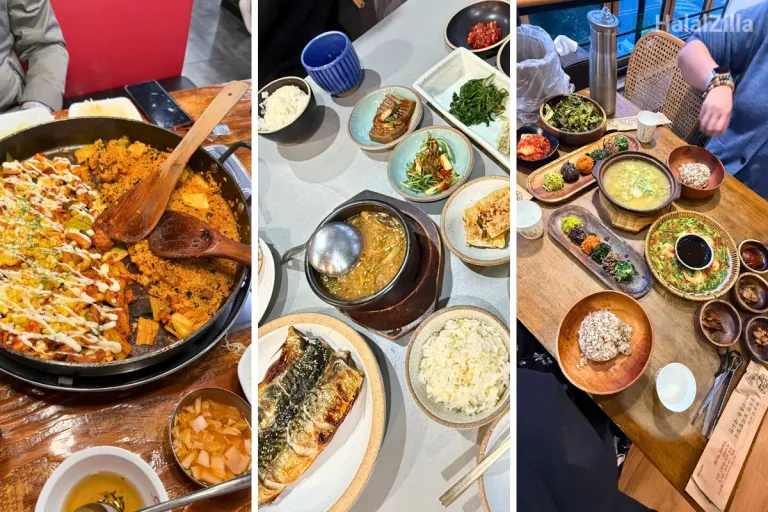 If you’re looking for pork-free Korean comfort food, Yoogane Haeundae is a must-visit! This spot is famous for its dak galbi, a spicy chicken stir-fry dish that’s beloved across Korea. I ordered the cheesy corn and chicken galbi, and honestly, it was one of my favourite meals in Busan.
If you’re looking for pork-free Korean comfort food, Yoogane Haeundae is a must-visit! This spot is famous for its dak galbi, a spicy chicken stir-fry dish that’s beloved across Korea. I ordered the cheesy corn and chicken galbi, and honestly, it was one of my favourite meals in Busan.
Another gem was Igasomssi, known for its hearty barley rice sets. We had ours with a comforting veggie soup and crispy prawn kimchi pancakes, all while enjoying a dazzling view of iconic Gwangan Bridge lighting up the night.
And for a cosy, homestyle experience, I fell in love with Soban, a charming, house-like restaurant that felt like dining in someone’s home. I had the perfectly grilled mackerel served with veggie soup, and the cherry blossom trees just outside the window made it all feel like a scene out of a K-drama.
HalalZilla Tip: If you don’t have time to make the long trip to Nampodong, you can head to Haeundae Traditional Market instead. It's centrally located and packed with great street food options!
Experience Busan’s top attractions
Busan is packed with jaw-dropping coastal views and activities and here are a few of my absolute favourite experiences you shouldn’t miss:
1. Haeundae Beach
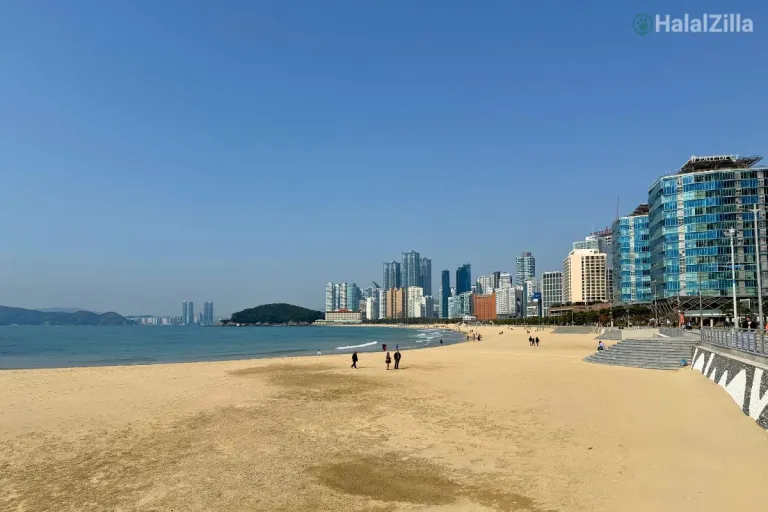 Arguably Busan’s most iconic beach, Haeundae Beach is the perfect place to soak up the sun, feel the sea breeze, and vibe with both locals and tourists.
Arguably Busan’s most iconic beach, Haeundae Beach is the perfect place to soak up the sun, feel the sea breeze, and vibe with both locals and tourists.
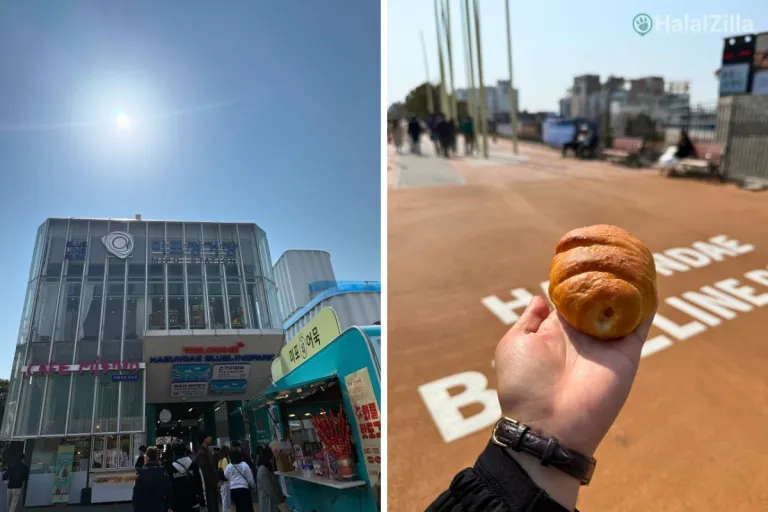 I also tried the super viral salt bread here from Salt Bread in Seaside, which was crispy, buttery, and worth the hype!
I also tried the super viral salt bread here from Salt Bread in Seaside, which was crispy, buttery, and worth the hype!
While you’re there, don’t miss Blue Line Park — the beach train takes you on a scenic ride along the coast from Mipo to Songjeong, and it’s honestly one of the prettiest ways to explore Busan.
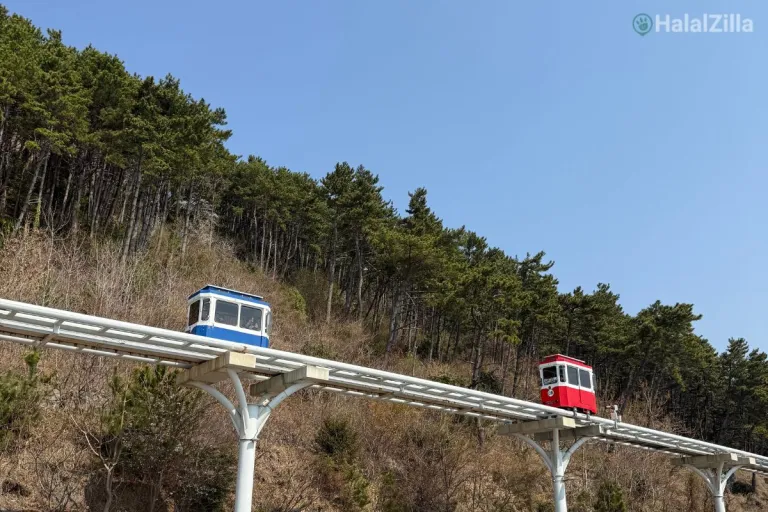 Just a short ride away via the Beach Train or Sky Capsule is the Cheongsapo Daritdol Observatory, a 72.5-metre-long glass skywalk. With the ocean right beneath your feet, walking across the transparent floor is both thrilling and so much fun.
Just a short ride away via the Beach Train or Sky Capsule is the Cheongsapo Daritdol Observatory, a 72.5-metre-long glass skywalk. With the ocean right beneath your feet, walking across the transparent floor is both thrilling and so much fun.
2. Arte Museum Busan
Arte Museum is one of Korea’s largest immersive media art spaces, and it’s truly a feast for the senses. Where light, sound, scent, and touch all come together to create stunning, multi-sensory experiences across beautifully curated rooms.
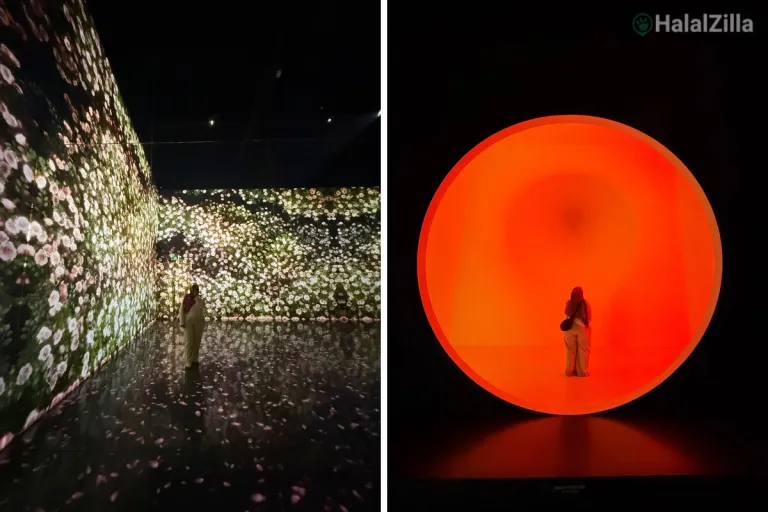 One of my favourites was the Rose Room, which was not just visually dreamy, but it even smelled like roses (my absolute favourite scent!). In the Rain Room, actual water droplets fall around you, mimicking gentle rain. Then there’s the Waves Room, where the crashing sounds of the ocean surround you so completely, it truly feels like you’ve been transported to the sea.
One of my favourites was the Rose Room, which was not just visually dreamy, but it even smelled like roses (my absolute favourite scent!). In the Rain Room, actual water droplets fall around you, mimicking gentle rain. Then there’s the Waves Room, where the crashing sounds of the ocean surround you so completely, it truly feels like you’ve been transported to the sea.
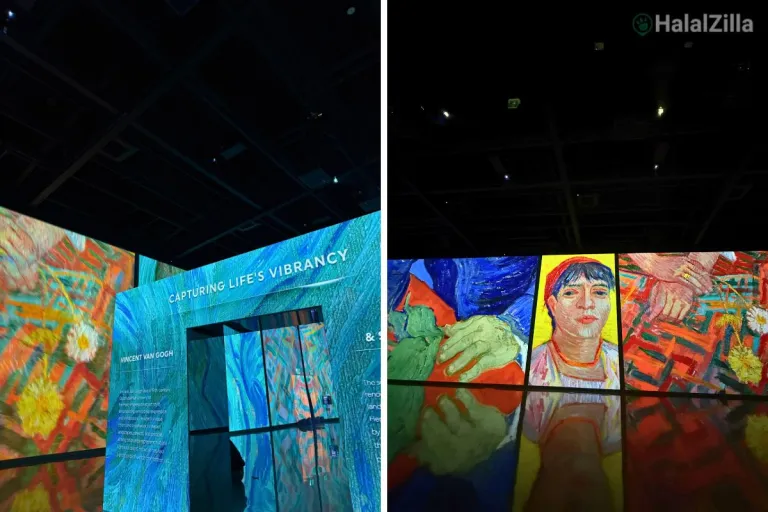 The final Green Room was a standout. It featured three distinct digital art displays playing on rotation — one showcasing the colourful energy of Busan, another highlighting a special collab with Musée d'Orsay that brought masterpieces by artists like Vincent van Gogh to life on huge screens.
The final Green Room was a standout. It featured three distinct digital art displays playing on rotation — one showcasing the colourful energy of Busan, another highlighting a special collab with Musée d'Orsay that brought masterpieces by artists like Vincent van Gogh to life on huge screens.
If you love immersive experiences like those at Singapore’s ArtScience Museum, this spot will be right up your alley. It even features a similar interactive section where you can draw your own creature and watch it come to life on screen. Honestly, I could’ve stayed for hours — it’s a must-visit for art enthusiasts and anyone who enjoys a touch of magic.
3. Beomeosa Temple
After soaking in all that sensory wonder, slow things down with a serene cultural escape. Founded in 678 during the Silla Dynasty, Beomeosa Temple is not just Busan’s most iconic temple, it’s also one of Korea’s most important Buddhist sites. Tucked away on the forested slopes of Geumjeongsan Mountain, the temple offers a peaceful escape from the city and a deep dive into Korea’s rich spiritual heritage.
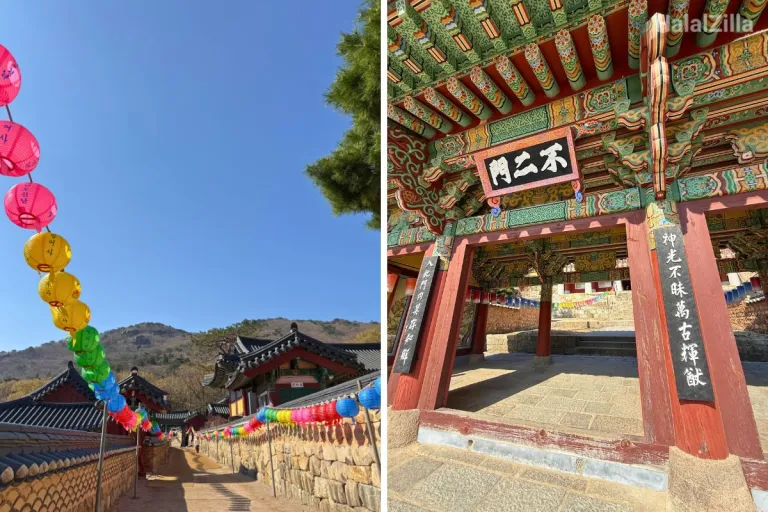 If you're up for something meaningful and immersive, Beomeosa is the only temple in Busan that offers a temple stay experience. And yes, Muslims can absolutely join too! The temple stay is open to people of all faiths and backgrounds, and you’re not required to participate in any religious rituals as the environment is designed to be respectful and inclusive.
If you're up for something meaningful and immersive, Beomeosa is the only temple in Busan that offers a temple stay experience. And yes, Muslims can absolutely join too! The temple stay is open to people of all faiths and backgrounds, and you’re not required to participate in any religious rituals as the environment is designed to be respectful and inclusive.
All meals served during the stay are vegetarian, which makes it easier for Muslim travellers looking to avoid non-halal food. If you’ve ever been curious about Buddhist culture or just want to try something different, this is a unique and serene way to experience another side of Busan.
HalalZilla Tip: If you're visiting around Buddha’s birthday, Beomeosa Temple is decorated with gorgeous lanterns! Head there early in the morning to skip the crowds and enjoy the tranquil vibes and stunning views in peace.
4. Fish cake making at Samjin Amook
Looking for a unique and tasty experience in Busan? Visit the Samjin Amook History Museum & Flagship Store — a one-stop spot where you can make 3 different types of Busan’s beloved fish cakes. A friendly instructor will guide you step-by-step through a hands-on workshop, so even if you’re a complete beginner, you’ll feel right at home.
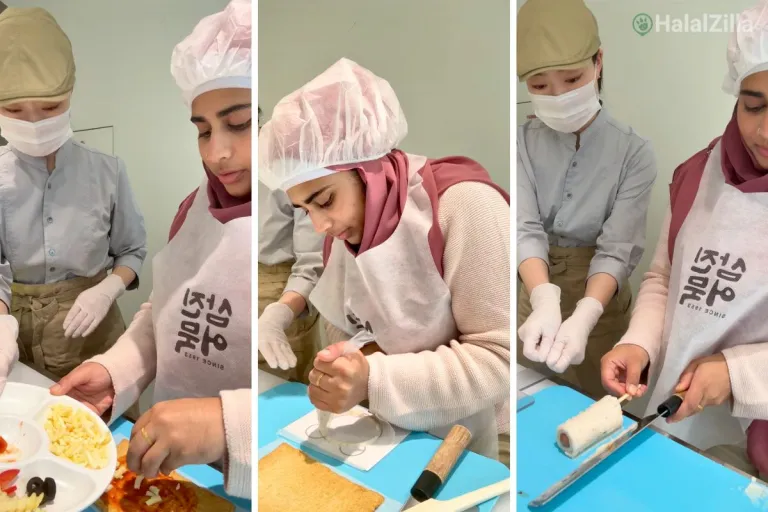 Pizza Fish cake: A simple one to start! I added toppings like cheese, olives, and peppers to a pre-fried fish cake (I skipped the pepperoni as it was pork).
Pizza Fish cake: A simple one to start! I added toppings like cheese, olives, and peppers to a pre-fried fish cake (I skipped the pepperoni as it was pork).
Teddy Bear Fish cake: Using a piping bag, I shaped the fish paste into an adorable teddy bear, smoothed it out with a knife, and decorated it with fun toppings like sunflower seeds and olives to create a charming teddy bear face.
Sausage Fish cake Roll: The most challenging of all! I had to spread the fish paste into a neat rectangle using a mould, then carefully wrap it around a chicken sausage. Rolling it smoothly required a special knife technique demonstrated by the instructor. It was trickier than it looked, but incredibly rewarding once I got the hang of it!
Once your fish cakes are ready, they’ll be fried or baked and served fresh at their dining area.
While you wait, explore the fish cake store packed with ready-to-eat and frozen varieties, plus mini exhibits showing how fish cakes are made back in the day and in the modern day at their factory. Upstairs, the museum shares the 70+ year history of the Samjin brand and offers insights into fishcake traditions around the world.
This fun, interactive activity is great for all ages, and you get a delicious reward at the end!
Other useful tips before you go
Don’t forget to pack a travel adapter! South Korea uses Type C and Type F plugs (the two round pin ones). Also, they drive on the opposite side of the road from Singapore (which is on the right side), so make sure to look right before looking left when crossing, especially at smaller intersections.
The local currency is the Korean Won, and as a rough guide, S$1 = around 1,078 KRW. I barely used any cash during my trip as most shops, restaurants, and transport systems accepted card or contactless payments. If you're only in town for a few days (I was in Busan for 4D3N), exchanging around S$100 - 150 cash should be more than enough for street food or small local purchases that might still be cash-only.
Korean is the main language, and while some locals speak a bit of English, Google Translate was my best friend throughout the trip which was super handy for signs and menus. For navigating around South Korea, Naver Map or Kakao Map are the best options as it has more accurate information, such as walking distances and public transportation routes, compared to Google maps.
Final thoughts
So there you have it — this guide to Busan covers everything from must-see sights and immersive experiences to tasty halal-friendly eats and handy travel tips. Whether you’re exploring stunning coastal views, diving into rich culture, or enjoying delicious food, Busan offers a welcoming and memorable adventure for Muslim travellers and everyone alike. Pack your bags and get ready to discover a city where tradition meets modern charm at every turn!
_____________________________________________________________________________________________
Special thanks to Busan Tourism Organization for inviting me on such a memorable trip in Busan!
Published at
About Author
Shahinah Begum
Subscribe our Newsletter
Get our weekly tips and travel news!
Recommended Articles
10 Best Halal-Friendly Destinations in The Philippines for Muslim Travellers 10 Best Places for Muslim Travellers to See Tulip Festivals in 2025 Fun Fact: Tulips didn’t actually come from the Netherlands but Türkiye!
10 Halal Anime Food Guide for Muslim Travellers in Japan Muslim-friendly versions of popular anime dishes across Japan!
Top 10 Popular Muslim-Friendly Destinations to Visit in 2025 Our schedules are packed, buddies!
10 Halal Restaurants in Bangkok to Satisfy Your Thai Cravings From Korean-style BBQ and Punjabi curries to award-winning shrimp Pad Thai, take your pick from these amazing Halal restaurants in Bangkok.
Latest Articles
Beast Land Riyadh 2025: MrBeast’s Theme Park Opens With Rides, Challenges & Muslim-Friendly Tips Experience the exclusive MrBeast’s theme park from 13 Nov to 27 Dec 2025!
11 Must-See Winter Illuminations in Osaka 2025–2026 for Muslim Travellers Experience winter in Osaka with lights, snow & festive fun
What Travellers Need to Know About Indonesia's Mount Semeru Eruption Mount Semeru’s status raised to alert level
What I Learned About Hong Kong While Travelling as a Muslim Oh come on, HK isn't just about Disneyland!
New Grab Sampan in Malaysia: A Muslim-Friendly Way to Explore the Sarawak River Grab Sampan can be booked online via cashless payments!

